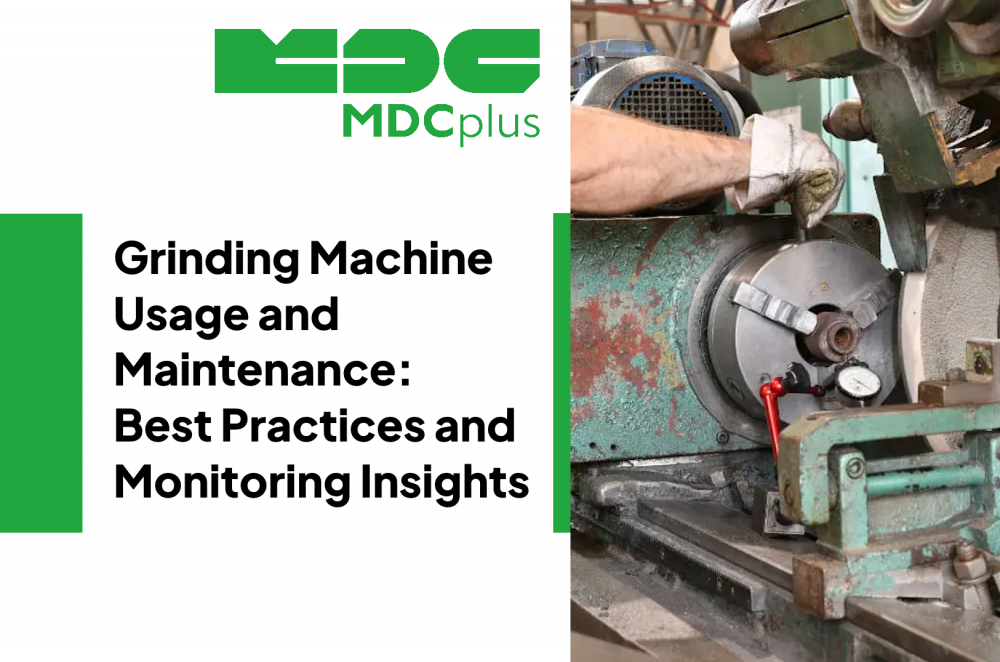Grinding Machine Usage and Maintenance: Best Practices and Monitoring Insights
Grinding machines are essential in modern manufacturing - used for finishing parts, achieving high-precision tolerances, and preparing surfaces. But like any precision equipment, their performance heavily depends on correct usage and disciplined maintenance.
1. Safe and Proper Use of Grinding Machines
Grinding machines can operate at high speeds and involve abrasive contact, making safety a top priority. Here are the key principles for safe usage:
-
Always wear safety goggles and protective clothing. Grinding can create sparks and high-velocity debris.
-
Ensure the workpiece is clamped firmly. Loose parts can shift during grinding and damage the wheel or machine.
-
Never exceed the rated RPM of the grinding wheel. Doing so risks wheel failure or explosion.
-
Use guards and shields. These are not optional—they are critical to operator safety.
-
Avoid side pressure on the wheel. Wheels are designed to handle axial force; lateral force weakens them.
-
Replace worn or cracked wheels immediately. Even a hairline fracture can lead to failure at speed.
-
Keep hands clear of the grinding zone. Use holding tools for small parts.
2. Daily and Routine Maintenance
Daily care is the backbone of grinding machine longevity. This includes:
-
Cleaning: Wipe down machine surfaces and remove dust and debris from the grinding area. Accumulated particles can wear components prematurely.
-
Lubrication: Follow the manufacturer's schedule for oiling and greasing. Use only the specified lubricants.
-
Check alignment: Misaligned tables or spindles can result in uneven finishes and component stress.
-
Inspect belts and pulleys: Look for wear, slack, or cracks.
-
Coolant system check: Ensure coolant flow is steady and filters are clean. Dirty coolant can scratch or burn parts.
3. Weekly and Monthly Maintenance
Go deeper with scheduled inspections:
-
Inspect wheel balance and dressing condition. Poor wheel shape leads to inconsistent results and heat buildup.
-
Verify spindle temperature and sound. Changes can indicate bearing issues or imbalance.
-
Examine electrical components. Check for loose connections, worn wires, or motor irregularities.
-
Review control panel alerts. Many machines include built-in diagnostic messages—don't ignore them.
4. Why Real-Time Monitoring Matters
Traditional maintenance relies on scheduled checks or operator intuition. While this can catch visible issues, many early-warning signs are missed—especially in the spindle, motor, or bearing systems.
Integrating monitoring systems (like MDCplus or sensor-based add-ons) enables:
-
Live tracking of spindle load, temperature, and vibration
-
Early detection of anomalies that operators may not notice (e.g., slight imbalance or micro-overheating)
-
Data-driven maintenance schedules, not just fixed intervals
-
Automated alerts when behavior deviates from normal ranges
-
Historical trend analysis to identify recurring or hidden issues
Real-time monitoring turns reactive maintenance into predictive maintenance, reducing unplanned downtime, extending component life, and helping maintenance teams prioritize work effectively.
5. Operator Responsibility
Even with automation and sensors, the role of the operator is crucial:
-
Stay alert to changes in machine behavior (sound, temperature, surface quality).
-
Keep a maintenance log. Record observations and interventions daily or weekly.
-
Report abnormalities early. Don’t wait for the machine to stop.
-
Use checklists. Standardized inspection routines reduce oversight and support consistency across shifts.
6. Summary
Proper use and consistent maintenance are non-negotiable for grinding machine performance. But to truly reduce risk and cost, manufacturers should combine routine checks with real-time machine monitoring. This blend of discipline and data allows for better planning, fewer breakdowns, and longer machine life.
Whether you're running one grinder or a full line of finishing equipment, building monitoring into your process is no longer optional—it's smart manufacturing.
About MDCplus
Our key features are real-time machine monitoring for swift issue resolution, power consumption tracking to promote sustainability, computerized maintenance management to reduce downtime, and vibration diagnostics for predictive maintenance. MDCplus's solutions are tailored for diverse industries, including aerospace, automotive, precision machining, and heavy industry. By delivering actionable insights and fostering seamless integration, we empower manufacturers to boost Overall Equipment Effectiveness (OEE), reduce operational costs, and achieve sustainable growth along with future planning.
Ready to increase your OEE, get clearer vision of your shop floor, and predict sustainably?
